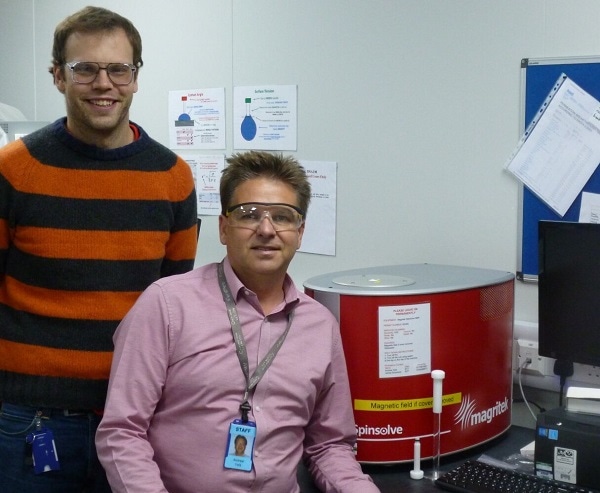Magritek, a leading provider of compact NMR and MRI instruments, reports on how a research group at the Johnson Matthey Technology Centre at Sonning Common is using their Spinsolve benchtop NMR spectrometer.

Dr Andrew York is a Senior Principal Scientist at the Johnson Matthey Technology Centre at Sonning Common, UK. His current role includes defining projects on catalysis and reaction engineering both internally and with external partners especially Cambridge University’s Chemical Engineering and Biotechnology Department.
Dr York's group purchased the Magritek Spinsolve benchtop NMR spectrometer to characterize materials of importance to the businesses in the company. For example, these could be supports for the numerous catalysts they manufacture, e.g. alumina. The characterization technique used is so-called relaxometry where they measure the relaxation times, T1 and T2, of the protons in a probe molecule that is in contact with the material. A typical experiment would be to impregnate the alumina pellet or powder with water, and measure the T1 and T2 of the protons in the water, but many different probe molecules can be used. This gives a measure of the absorption strength of the probe molecule on the support – strongly adsorbed probe molecules have shorter T1 and 2. Describing why they use this technique, Dr York says “The relaxometry technique in particular is very fast and can be used very easily in the laboratory to get information about our materials. This means we can develop quick and low cost measurements for control of materials going into processes.”
Spinsolve has also been used for pulsed field gradient NMR experiments to investigate the movement of molecules in the support, by measuring their diffusion. This required pulsed field gradient coils and gradient amplifiers to be added to the Spinsolve. Using this experiment Dr York can also measure how quickly molecules diffuse in the phase of interest – e.g. water molecules diffusing in bulk water (as they are all moving around all the time), or diffusing around in the catalyst supports where their movement is restricted. This helps him understand the transport of reactant and product molecules in the catalysts, as clearly he does not want catalyst performance to be hindered by how fast the molecules can access the expensive active sites on the catalyst (which often include precious metals, such as platinum and rhodium).
Discussing the benefits of using Spinsolve, Dr York continued: “It is low cost, but also powerful and so far has allowed us to do many of the experiments we need to do. So if need be we can also do quick spectroscopy experiments. However, it is the Expert software that allows most of the real user flexibility. The continuing development of this software by Magritek helps us make the most of the machine in our very non-standard applications.”
Magritek's Spinsolve benchtop NMR spectrometer is supplied worldwide to academics in teaching and research; also to industry for research and reaction monitoring through to quality control use. To obtain full details of the Spinsolve benchtop NMR spectrometer and the full range of analytical products from Magritek, visit, www.magritek.com.